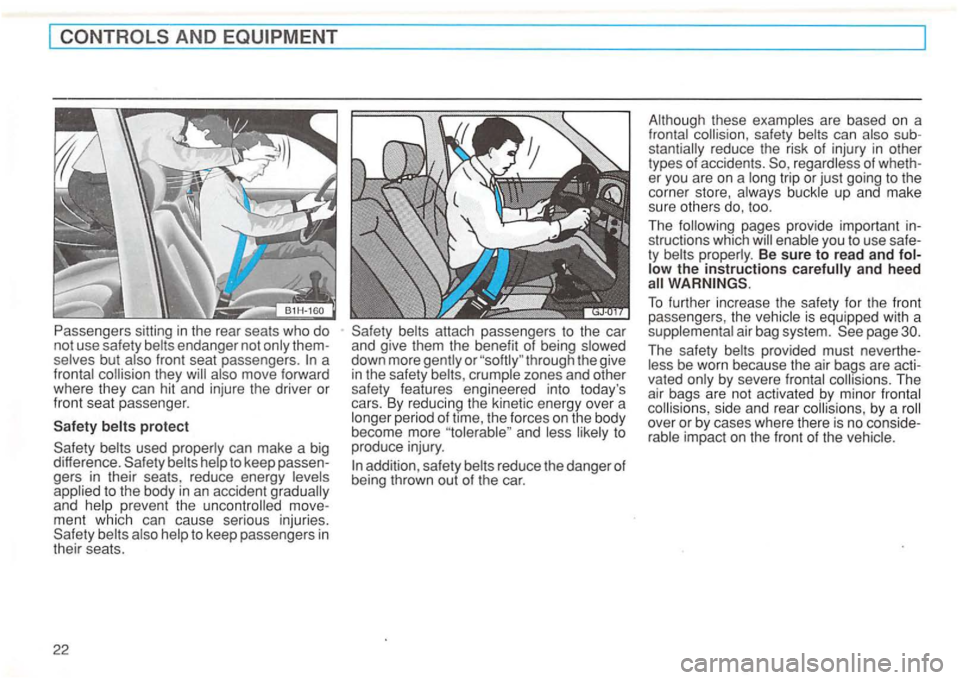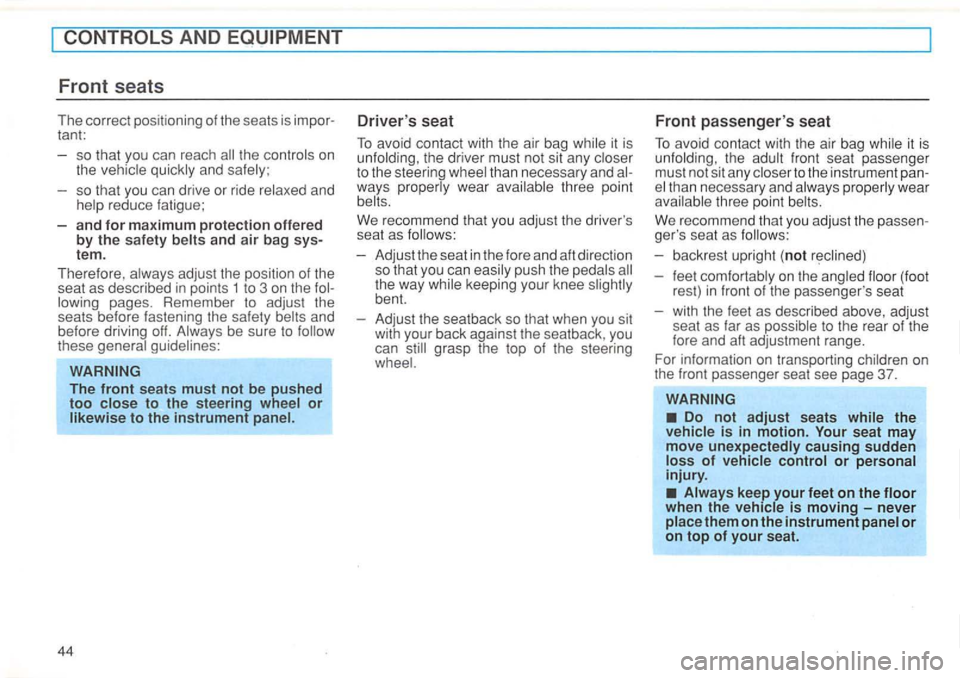Page 4 of 274
TABLE
brake compartment,
illustration . . . . . . . . . . . . . . . . . . 6 Automatic
transmission ............. 51 ......................
Warning and indicator ........... 8 Coat hooks, ....... 91
Keys, . . . . . . . . . . . . . . 1 12 steering ........... 92
Anti-theft switch ... 58 Roof rack Roof ............. 93
Do ors , R ea r
. . . . . . . . . . . . . . . . . 15, 16
........................
Sta rting procedures ................. 59
S topping engine .
....... ............ 61
.................. 62 T he first km) -
and afterwards ..................... 94
Air bag system
..................... Warning ............ 67 .......... 95
safety ........................ 36
H ea d r estra ints
..................... 43
Front seats
........................ 44
Rear seat
......................... 46
Lugga ge compartm ent
.............. 49
dimmer
switch .................... .... 78
Cruise
Air conditioning .................... 82
4
Page 25 of 274

AND
also move forward
where they can hit and injure the driver or
front seat passenger.
also help to keep passengers in
their seats.
22
attach passengers to the car
and give them the benefit of being slowed
down more
through the give
in the safety crumple zones and other
sa fety features engineered into today's
cars. By
reducing the kinetic energy over a
longer period of time , the force s on the body
become more
and less likely to
produce injury.
addition , safety belts reduce the danger of
being thrown out of the car. Although
these examples are based
on a
fron tal
red uce the risk of injury in other
types of accide nts. regardless of er you are on a long trip or just going to the
corne r store , always buckle up and make
sure others do , too.
Th e
page s provide important structions which
To further inc rease the safety for the front
passengers, the vehicle is equipped with a
supplementa l ai r bag system.
page
provided must
vated only by severe frontal co llisions. The
air bags are not ac tivated
by a roll
over or by cases where there is no rable impact on the fr ont of the vehicle.
Page 27 of 274
AND
and described in chapter. For instance, do not wear part of
to become
damaged by being caught door or seat hardware . keep
in the
restraint
systems.
24
The
Safety that have been worn and in an accident must be by an authorized
Never modify, disassemble or attempt to repair the safety in your
which must be used in the interests of
safety whenever the is in motion .
The front seats are equipped with
The rear seat outside passenger positions are equipped with three-point safety
The combi nation have retractors . T he system adjusts to your size and moveme nts as
when you drive up or down
a steep or in a sharp curve.
Page 40 of 274
rearward facing child seats only in rear seat area. Use of a
rearward facing child seat on front passenger seat lead to serious injury to the child when air bag
inflates. When using a forward facing
child seat on front seat, always make
sure that passenger seat is in
rearmost position.
- 35 mph
Page 46 of 274
Head restraints
The padded head restrai nts on the front and
rear seats are adj usta ble.
head restrai nts acco rding to the oc
c up ant' s heig ht. positioned head
r es tra in ts, together with the use of sa fety
For maximum protection, the upper edge
43
Page 47 of 274

AND
tant: so that you can reach
the controls on
the quickly and safely ;
so that you can drive or ride relaxed and
reduce fatigue;
a
nd for maximum p rotec tion offe re d by the sa fety b elts and air bag tem.
T herefore , always adju st the position of the
seat as describ ed in points 1 to 3 on the
lowing pages. Remember to adjust the
seats before fasteni ng the safety belts and
before driving off. Always be sure to
these general guidelines:
to the instrument
44
Driver 's seat
To avoid contact with the air bag while it is
unfolding , the driver must not sit any
to the steering wheel than necessa ry and ways properly wear
the way while keeping your knee bent.
Adjust the seatback so that when you sit
with your back against the seatback , you
can
grasp the top of the steering
Fron t passenger 's seat
To avoid contact with the air bag while it is
unfo ld ing , the adult fr ont seat passenger
must not sit any closer to the instrument
el than necessary and always properly wear
avai lable three point
We recommend that you adjus t the
- backrest upright (not
-feet comfortab ly on t he angled floor {foot
re st) in front of the passenger 's seat
- with the feet
as descr ibed above , adjust
seat as far as possible to the rear of the
for e and aft adjustment range.
For information on trans porting children on
the front passenger seat see page 37.
Do not adjust seats
Page 48 of 274
To reduce the risk of serious personal injury in an accident, front seat passengers must never ride in a
moving with the seatback
reclined . The risk of personal injury increases with increasing rearward of the seatback .
are properly positioned on the body. positioned safety can cause serious personal injury in an accident.
For driver's and pas senger 's protection, make sure front seats and
seatbacks are securely in
Never store items under the seats.
Loose objects can inte rfere with the
seat latching mechanism and can cause injury in an accident .
1 -Forward and backward adjust-
ment
in f ront of seat.
s eat into positi on.
curely lock ed int o posit ion .
2-Seatback adjustment
Turn wheel on outboard side of seat ion , with your body weight ta ken off the back .
AN D
you r body weight fo rw ard and
Page 49 of 274
Do not drive the
reduce injuries.
Do not passengers to occupy the rear surface is in motion.
To inc rease the size of the
with the two parts
can be moved
To prevent damage , the front seats must be
posit ioned so that the rear seat does not
touch the front seats when the rear seat is
by the and
the cushion forward (arrow 2).
knob in the rear seat rest in direction of arrow and back